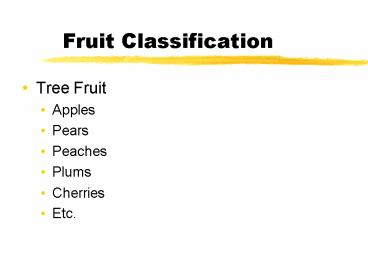Fruit Classification - PowerPoint PPT Presentation
1 / 24
Title:
Fruit Classification
Description:
Weed control and row-middle management. Herbicide or cultivated strips under row. Eliminates weed competition for water and nutrients. Reduces disease and insect ... – PowerPoint PPT presentation
Number of Views:3337
Avg rating:3.0/5.0
Title: Fruit Classification
1
Fruit Classification
- Tree Fruit
- Apples
- Pears
- Peaches
- Plums
- Cherries
- Etc.
2
Fruit Classification (cont.)
- Small Fruit
- Strawberries
- Blueberries
- Brambles (blackberries and raspberries)
- Grapes
- Etc.
3
General Characteristics of Fruit Crops
- Genetics
- Heterozygous (Dont breed true from seed.)
- Vegetatively propagated (cloned)
- Grafted onto rootstocks
- Size control
- Adaptation
- Rooted cuttings
4
Growth Habit
- Perennial
- Live for many years
- Several years of development before fruit
production - Woody
- Apple, peach, cherry, etc.
- Grape, blueberry, brambles, etc.
- Herbaceous
- Strawberry (also grown as annual)
5
Plant Development
- Juvenile to mature (vegetative to fruit)
- Varies by crop (1 yr. To 5-7 yrs.)
- Fruit buds develop during the summer, go dormant,
over winter, then produce flowers/fruit - Cold injury from winter freezes and spring frosts
cause a loss of fruit production
6
Factors for Successful Fruit Production
- Site Selection
- Cultivar (Variety) Selection
- Cultural Management
7
Site Selection
- Minimum winter temperature
- Fruit bud survival
- Length of growing season
- Date of last Spring frost
- Date of first Fall frost
- Air drainage (to avoid frost problems and aid in
disease control) - Slope
- Prevailing winds-orientation of rows
- Borders/fence rows/woods
8
Site Selection (cont.)
- Sunlight exposure
- Slope aspect
- Orientation of rows
- Shade from borders
9
Site Selection (cont.)
- Soil characteristics
- Soil texture (particle sizes)
- Sand SiltClay
- Soil Types
- Sand70 sand
- Poor water holding capacity
- Low organic mater content
- Nutrient leaching problems
10
Site Selection (cont.)
- Soil characteristics (cont.)
- Soil Types (cont.)
- Clay35 clay
- High water holding capacity
- Poor aeration due to water-logging
- Poor root penetration
- Increased disease problems
- Harder to cultivate
- Loam mixture of sand, silt and clay that
displays intermediate properties
11
Site Selection (cont.)
- Soil characteristics (cont.)
- Soil Depth
- Adequate rooting depth (30 )
- Low water table
- Lack of impervious subsoil layer
- Soil Chemistry
- Proper pH (5.5 to 7.0) (Except blueberries that
require acid soils 4.5 to 5.2) - Moderate fertility (N, P, K)
- High organic matter content
12
Site Selection (cont.)
- Soil characteristics (cont.)
- Idea soil for fruit production
- Sandy loam or loam texture
- Deep, no impervious layers
- Well-drained with a low water table
- Proper pH
- Moderately fertile
- High organic matter content
- Free of troublesome weed, disease and insect pests
13
Cultivar (Variety) Selection
- Adaptation
- General
- Cold hardiness
- Heat tolerance
- Days needed for fruit maturity
- Date of bloom (frost avoidance)
- Disease and insect resistance
- Site specific Match cultivar to site
- Adaptation to soil type
- Disease and insect resistance
- Frost tolerance
14
Cultivar (Variety) Selection (cont.)
- Marketing (Intended Use)
- Home use
- Pick-Your-Own sales
- Retail sales
- Wholesale sales (processing)
15
Cultural Practices
- Pruning and training systems
- Achieve optimum balance between vegetative and
reproductive growth - Develop and maintain proper plant form
- Must have understanding of a plants growth habit
to know how to prune and train
16
Cultural Practices (cont.)
- Tree Fruit
- Training to desired tree form and size
- Improve sunlight penetration
- Increased yields, better fruit quality
- Ease of harvest
- Small Fruit
- Balance fruit load to vegetative growth
- Improve sunlight penetration
- Reduce competition between plants
- Fill row space
- Improve fruit quality and yields
17
Cultural Practices (cont.)
- Disease and insect control
- Cultural control methods
- Resistant cultivars
- Proper pruning
- Proper fertilization
- Proper irrigation practices
18
Cultural Practices (cont.)
- Disease and insect control (cont.)
- Chemical control methods
- Proper pest identification
- Proper pesticide choice
- Proper timing of application
19
Cultural Practices (cont.)
- Weed control and row-middle management
- Herbicide or cultivated strips under row
- Eliminates weed competition for water and
nutrients - Reduces disease and insect problems
20
Cultural Practices (cont.)
- Weed control and row-middle management (cont.)
- Sod cover in row middles
- Provides site for beneficial insects
- Allows easy equipment access
- Prevents soil erosion
21
Cultural Practices (cont.)
- Plant Nutrition
- To maintain health and vigor for consistent,
long-term production - Soil testing
- Before planting to determine nutrient status, pH,
EC, etc., so adjustments can be made - Foliar testing
- After establishment to determine nutrient status
of crop
22
Cultural Practices (cont.)
- Integrated pest management
- Use resistant varieties where possible
- Scout for insect and disease development
- Pheromone traps/insect counts
- Economic thresholds
- Proper timing of pesticide applications
- Monitor weather conditions to forecast insect or
disease development - Protect beneficial insects with proper pesticide
selection - Grow cover crops to harbor beneficial insects
- Maintain proper nutrient status
23
Cultural Practices (cont.)
- Harvest and handling
- Harvest
- Hand
- Machine
- Harvest parameters are determined by intended use
- Sugar content (Brix, soluble solids)
- Sugar / acid ratio
- Taste or texture
- Color
24
Cultural Practices (cont.)
- Harvest and handling (cont.)
- Post-harvest handling
- Cooling
- Controlled atmosphere storage (low O2, high CO2)
- Modified-atmosphere packaging (MAP)

